历届亚运会会徽片
- 格式:doc
- 大小:118.00 KB
- 文档页数:2


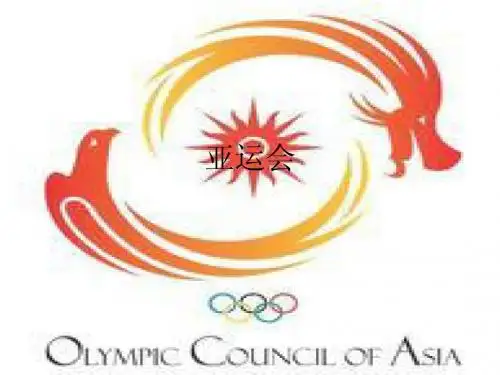
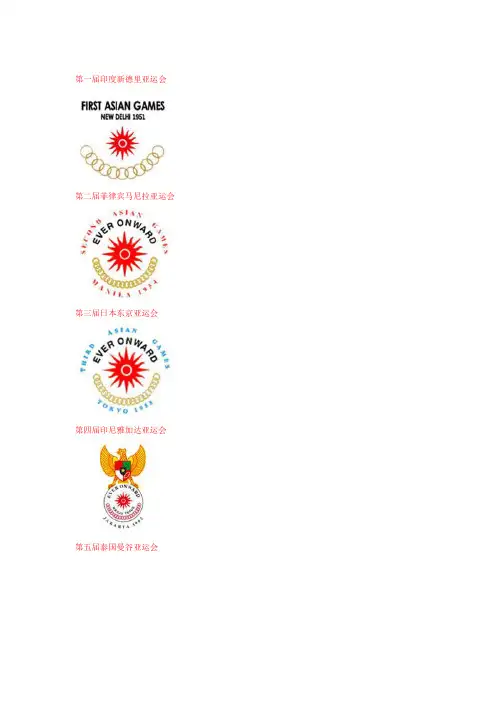
第一届印度新德里亚运会第二届菲律宾马尼拉亚运会第三届日本东京亚运会第四届印尼雅加达亚运会第五届泰国曼谷亚运会第六届泰国曼谷亚运会第七届伊朗德黑兰亚运会第八届泰国曼谷亚运会第九届印度新德里亚运会第十届韩国汉城亚运会第十一届中国北京亚运会第十二届日本广岛亚运会第十三届泰国曼谷亚运会第十四届韩国釜山亚运会第十五届卡塔尔多哈亚运会2010年广州亚运会会徽会徽创意源于一个美丽的传说。
相传很久以前,有一年广州大旱,庄稼颗粒无收,百姓无计可施,只好日夜祈求天神降福,他们的虔诚终于感动了五位仙人。
仙人们骑着毛色各异、口衔稻穗的五只仙羊,飘然降临此地。
他们把谷穗赠给人们,祝愿这里"永无荒饥"。
说完就腾空而去,五只仙羊则变成石头留在人间。
从此以后,这里年年风调雨顺,五谷丰登。
因为这个神奇的传说,广州被称作"羊城"、"穗城"。
今天,广州越秀公园内有五羊雕像,是广州最具象征意义的城徽。
在中国的传统文化中,"羊"是吉祥之物,能给人带来幸运。
"羊"在中国古代文字中与"祥"相通,"吉祥"也可写作"吉羊"。
中国文字的"美"字,是由"羊"和"大"构成的,"羊""大"为"美"是中国传统的美学观念。
中国文字中,许多与美好相联系的字和词,都与"羊"字相关。
因此,取"羊"的创意,寓意着广州人民将以最美好的姿态迎接2010年亚运会,将把最美好的东西献给亚洲和世界各国人民。
该会徽设计,以柔美上升的线条,构成了一个造型酷似火炬的五羊外形轮廓,构图以抽象和具象相合,在灵动、飘逸中不失稳重,象征着亚运会的圣火熊熊燃烧、永不熄灭。
既体现了广州的城市象征,也表达了广州人民的美好愿望,还表现了运动会应有的动感。
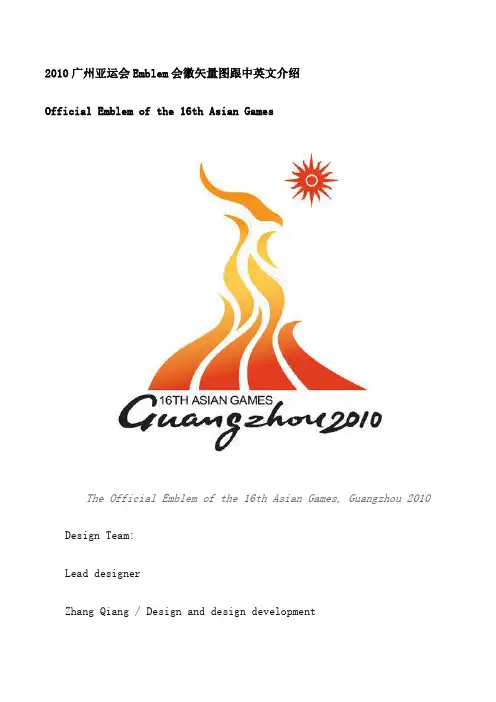
2010广州亚运会Emblem会徽矢量图跟中英文介绍Official Emblem of the 16th Asian GamesThe Official Emblem of the 16th Asian Games, Guangzhou 2010 Design Team:Lead designerZhang Qiang / Design and design developmentCo-designersZhang Yi, Wu Zhonghao, Li ChenjiaCompany:Zhongjia (Guangzhou) Design Co LtdThe concept(观念): The design of the Games emblem(标志) is derived from a legend(传说) about the City of Guangzhou: As the legend goes, a long time ago, the farm lands in Guangzhou ran dry, food could not be grown and the people experienced a famine(饥荒). They could do nothing but pray(祈祷) to the heavens(天堂) for luck. Moved by their piety(虔诚), Five Immortals(神仙) descended(下来) from the sky, riding on goats with coats of different colors, each holding rice ears(谷穗) in its mouth. The Immortals gave the rice ears to the people and declared that the land would be free from famine.Afterwards, they disappeared into the sky. The five goats that were left behind turn into stone. From that time on, Guangzhou reaped(收割) a bumper(同类中的特大者) harvest of grain every year and grew into one of the most prosperous(繁荣的,成功地) cities in China.For this reason Guangzhou is also known as the City of Goats or the City of Rice Ears.The Statue of the Five Goats in Guangzhou's Yue Xiu Park is a reminder(提醒物) of this legend and has, over the years, become the symbol of the city and one of its most well known landmarks(地标).Stone Statue of Five Goats in Yuexiu Hill in Guangzhou, a symbol of the host city of the 16th Asian Games and original element of the officialemblem design.In traditional Chinese culture, the "goat" is an auspicious(吉利的,幸运的) animal that brings luck and in the language of ancient China, the character "羊" (yang or goat) is identical to the character "祥" (xiang, meaning luck). The character "美" (mei, beauty) is composed(组成,构成)of the characters "羊" (yang, goat) and "大" (da, big), in keeping with the traditional Chinese belief that a “big goat" is beautiful.In the Chinese language, many words and characters associated(把…联系起来) with the meaning of beauty are often related to the character "羊" (yang, goat).The beloved(可爱的) goat is embodied(赋予…的形体) in the emblem design, representing(象征) Guangzhou its people and their readiness to embrace() the 2010 Asian Games and present the best of the city to people across Asia and the world.The soft and uplifting lines in the emblem design outlines a contour of the Five Goats that is identical to the shape of a torch. The design of the emblem, a combination of the concrete and the abstract, of grace and ease, manifests the ever-burning sacred flame of the Asian Games. The emblem represents a perfect symbol of Guangzhou, the best wishes of its people, and the dynamics of the Asian Games.About the Emblem: The soft and vibrant contours of the emblem symbolize the running lanes of an athletics track, the sacred, forever burning flames of an Asian Games Torch and finally, the silhouette of the Statue of the Five Goats. The design, a combination of the concrete and the abstract, of grace and finesse, therefore cleverly combines elements of Guangzhouand the Asian Games at the same time. The Emblem perfectly represents Guangzhou, the sports aspirations of its people and the dynamism of the Asian Games.广州亚运的会徽设计,以柔美上升的线条,构成了一个造型酷似火炬的五羊外形轮廓,构图以抽象和具象相合,在灵动、飘逸中不失稳重,象征着亚运会的圣火熊熊燃烧、永不熄灭。
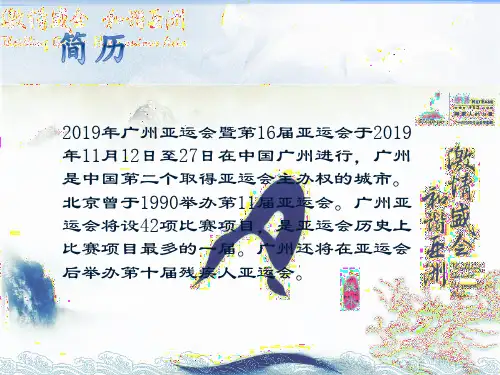

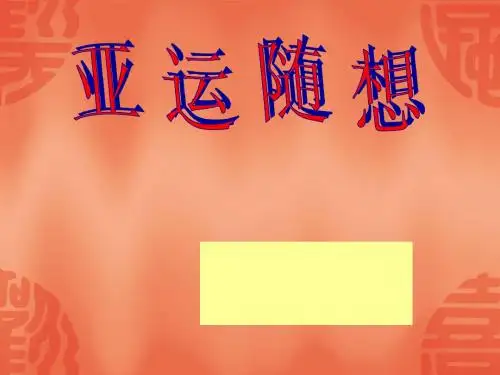
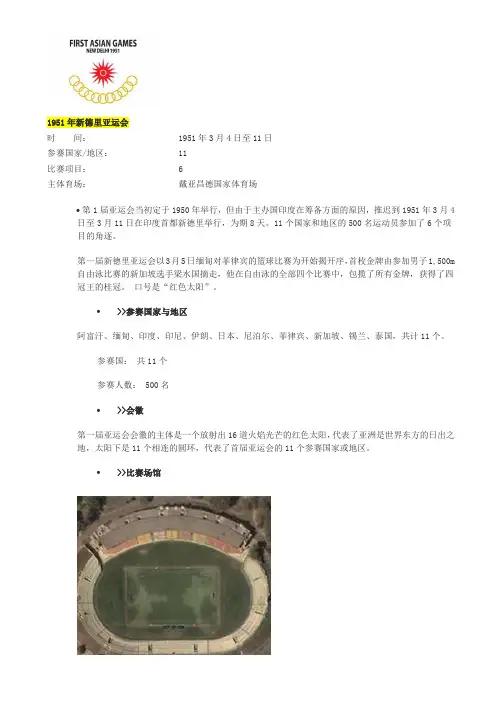
1951年新德里亚运会时间:1951年3月4日至11日参赛国家/地区:11比赛项目: 6主体育场:戴亚昌德国家体育场•第1届亚运会当初定于1950年举行,但由于主办国印度在筹备方面的原因,推迟到1951年3月4日至3月11日在印度首都新德里举行,为期8天。
11个国家和地区的500名运动员参加了6个项目的角逐。
第一届新德里亚运会以3月5日缅甸对菲律宾的篮球比赛为开始揭开序,首枚金牌由参加男子1,500m 自由泳比赛的新加坡选手梁水国摘走,他在自由泳的全部四个比赛中,包揽了所有金牌,获得了四冠王的桂冠。
口号是“红色太阳”。
•>>参赛国家与地区阿富汗、缅甸、印度、印尼、伊朗、日本、尼泊尔、菲律宾、新加坡、锡兰、泰国,共计11个。
参赛国:共11个参赛人数: 500名•>>会徽第一届亚运会会徽的主体是一个放射出16道火焰光芒的红色太阳,代表了亚洲是世界东方的日出之地,太阳下是11个相连的圆环,代表了首届亚运会的11个参赛国家或地区。
•>>比赛场馆戴亚昌德国家体育场是1951年的第一届亚运会的主体育场。
这是一座位于印度新德里的曲棍球体育场,能容纳25000人一同观看比赛,它以印度前曲棍球运动员戴亚昌德而命名。
•>>比赛项目田径、游泳、足球、自行车、篮球、举重>>奖牌榜第一名日本金牌24枚,银牌20枚,铜牌14枚第二名印度金牌15枚,银牌18枚,铜牌19枚第三名伊朗金牌 8枚,银牌 5枚,铜牌 2枚1954年马尼拉亚运会时间:1954年5月1日至8日参赛国家/地区:18比赛项目:8主体育场:马尼拉黎刹纪念体育场•第二届亚洲运动会于1954年5月1日在菲律宾菲律宾首都马尼拉举行,会期为8天。
1954年5月1日在菲律宾总统拉蒙·F·马格赛赛(Ramon Magsaysay)主持下开幕典礼安排在5月1日于马尼拉黎剎纪念体育场举行。
菲律宾总统拉蒙·麦格赛赛用英语宣布马尼拉第2届亚洲运动会开幕。
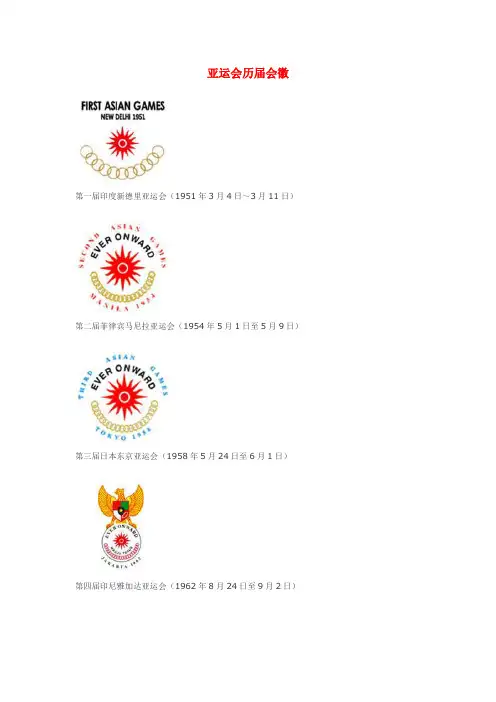
亚运会历届会徽
第一届印度新德里亚运会(1951年3月4日~3月11日)
第二届菲律宾马尼拉亚运会(1954年5月1日至5月9日)
第三届日本东京亚运会(1958年5月24日至6月1日)
第四届印尼雅加达亚运会(1962年8月24日至9月2日)
第五届泰国曼谷亚运会(1966年12月9日至12月20日)
第六届泰国曼谷亚运会(1970年12月9日至12月20日)
第七届伊朗德黑兰亚运会(1974年9月1日至9月16日)
第八届泰国曼谷亚运会(1978年12月9日至12月20日)
第九届印度新德里亚运会(1982年11月19日至12月4日)
第十届韩国汉城亚运会(1986年9月20日至10月5日)
第十一届中国北京亚运会(1990年9月22日至10月7日)
第十二届日本广岛亚运会(1994年10月2日至10月16日)
第十三届泰国曼谷亚运会(1998年12月6日至10月20日)
第十四届韩国釜山亚运会(2002年9月29日至10月14日)
第十五届卡塔尔多哈亚运会(2006年12月1日至12月15日)。
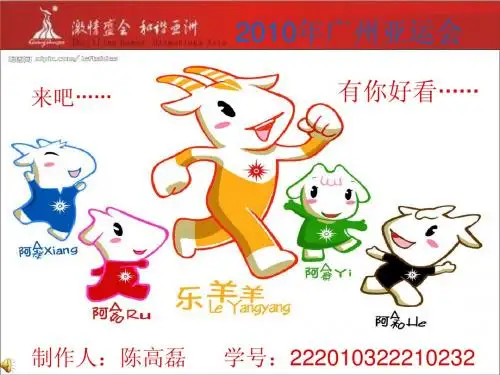
亚运会体育标志图标
亚洲运动会是亚洲地区最高规格的综合性运动盛会之一,每四年一届,主要是各国与地区之间的体育对抗竞技。
亚洲运动会每回都有一个独特的体育标志图标,这个标志图标是亚运会的视觉形象的核心,代表了亚洲运动会的精神和价值观。
亚洲运动会的体育标志图标通常包括了各种元素,如体育运动、地域特色、文化符号等。
这些元素的融合和表达,能够传达出举办城市和国家的独特魅力和风貌。
举例来说,2018年亚洲运动会的体育标志图标是由印尼举办的,他们选取了独特的印尼巴厘岛的文化符号——昆巴欧舞蹈的形象作为标志图标的主要元素。
昆巴欧舞蹈是巴厘岛的传统舞蹈之一,代表了巴厘岛的独特文化和传统价值观。
标志图标中的舞蹈人物身姿优美,属于典型的印尼舞蹈动作,表达了奋勇向前、团结协作的精神。
亚洲运动会的体育标志图标通常会采用明亮鲜艳的色彩,这样能够增强人们对于亚运会的印象和记忆。
另外,标志图标也会加入一些动态元素,比如体育运动的姿势、运动道具等,以表达对于运动的热情和激情。
出色的亚洲运动会体育标志图标能够成为亚运会的形象代言,彰显了亚运会作为综合性运动盛会的独特魅力和文化底蕴。
通过体育标志图标的传播,能够激励和引导人们积极参与运动,提升整个社会的体育意识和素质。
综上所述,亚洲运动会体育标志图标是亚运会形象的核心,代表了亚洲运动会的精神和价值观。
它具有独特的文化元素和亚洲地区的风貌,能够激发人们对于运动的热爱和参与。
通过亚洲运动会体育标志图标的传播,能够提升亚运会的影响力和认知度,推动体育事业的发展和进步。
杭州亚运会二级标志手册摘要:I.杭州亚运会简介- 亚运会历史- 杭州亚运会举办时间、地点、规模II.二级标志手册概述- 二级标志的定义和作用- 杭州亚运会二级标志手册的目的和意义III.杭州亚运会二级标志内容- 可持续标志- 公众参与标志- 测试赛标志- 智能标志- 火炬传递标志- 文化活动标志- 志愿者标志IV.二级标志的设计理念和特点- 设计理念- 设计特点V.二级标志的应用场景和效果- 应用场景- 效果展望正文:随着杭州亚运会的日益临近,亚运会的筹备工作正在紧锣密鼓地进行中。
近日,杭州亚运会二级标志手册正式出炉,为亚运会的宣传和推广提供了重要的视觉形象支持。
杭州亚运会将于2022年9月10日至25日在杭州举行,这是我国继北京、广州之后,第三次举办亚运会。
本届亚运会共有45个参赛国家和地区,预计将有10,000多名运动员参加。
此次亚运会的举办,将有利于提升杭州的城市形象,推动浙江省乃至全国的经济、文化、体育事业发展。
二级标志手册是亚运会视觉形象体系的重要组成部分,它包括可持续标志、公众参与标志、测试赛标志、智能标志、火炬传递标志、文化活动标志、志愿者标志七种。
这些二级标志将作为亚运会会徽等一级形象标志的补充,应用于对应的特定场景。
二级标志的设计理念以“和合”为核心,体现了杭州亚运会“和谐、和睦、和平”的办赛理念。
在设计特点上,二级标志采用简洁、现代的设计手法,以亚奥理事会会徽为基本元素,融入了杭州地域特色和文化元素,形成了具有鲜明时代感和地域特色的二级标志。
在应用场景方面,二级标志将广泛应用于亚运会各类宣传、推广活动中,包括电视、报纸、网络、户外广告等媒体。
在各类活动现场,观众也将看到二级标志的精彩呈现。
这些标志将有助于传播亚运会理念,提升亚运会的知名度和美誉度。
总体来说,杭州亚运会二级标志手册的发布,标志着亚运会筹备工作进入了新的阶段。
历届亚运会回顾第⼀届亚运会:印度新德⾥第⼀届亚运会——新德⾥⽇期:1951.3.4-3.11(为期8天)参赛国:阿富汗、缅甸、印度、印尼、伊朗、⽇本、尼泊尔、菲律宾、新加坡、锡兰、泰国,共计11个。
参赛⼈数:500名⽐赛项⽬:⽥径、游泳、⾜球、⾃⾏车、篮球、举重会徽:第⼀届亚运会会徽的主体是⼀个放射出16道⽕焰光芒的红⾊太阳,代表了亚洲是世界东⽅的⽇出之地,太阳下是11个相连的圆环,代表了⾸届亚运会的11个参赛国家或地区。
⽐赛场馆:戴亚昌德国家体育场戴亚昌德国家体育场是1951年的第⼀届亚运会的主体育场。
这是⼀座位于印度新德⾥的曲棍球体育场,能容纳25000⼈⼀同观看⽐赛,它以印度前曲棍球运动员戴亚昌德⽽命名。
⼤会内容:第1届亚运会当初定于1950年举⾏,但由于主办国印度在筹备⽅⾯的原因,推迟到1951年3⽉4⽇⾄3⽉11⽇在印度⾸都新德⾥举⾏,为期8天。
11个国家和地区的500名运动员参加了6个项⽬的⾓逐。
第⼀届新德⾥亚运会以3⽉5⽇缅甸对菲律宾的篮球⽐赛为开始揭开序,⾸枚⾦牌由参加男⼦1500m⾃由泳⽐赛的新加坡选⼿梁⽔国摘⾛,他在⾃由泳的全部四个⽐赛中,包揽了所有⾦牌,获得了四冠王的桂冠。
⼝号是“红⾊太阳”。
奖牌榜:第⼀名⽇本⾦牌24枚,银牌20枚,铜牌14枚第⼆名印度⾦牌15枚,银牌18枚,铜牌19枚第三名伊朗⾦牌 8枚,银牌 5枚,铜牌 2枚重⼤事件:1.因朝鲜战争爆发,韩国没有派代表团参加。
2.因⽇本加⼊联合国⽽允许⽇本参加本次⼤会。
共有489名运动员(其中⼥运动员31名)在第⼀届亚运会6类运动57项⽐赛进⾏⾓逐。
各项奖牌分配情况为:⽥径33块、游泳8块、举重7块、⾃由车4块、跳⽔2块、⽔球、篮球、⾜球各1块,共57块。
其中,伊朗队夺得了举重项⽬的所有⾦牌。
第19届亚运会会徽名
摘要:
1.亚运会的背景和意义
2.第十九届亚运会会徽的正式发布
3.会徽的设计元素和寓意
4.会徽的评价和影响
正文:
亚洲运动会(Asian Games),简称亚运会,是亚洲地区最具规模和影响力的综合性运动会。
自1951年开始,亚运会已经成功举办了18届,第19届亚运会将于2022年在我国杭州举行。
亚运会不仅是对各国运动员竞技水平的检验,更是展示了亚洲各国文化、友谊和团结的重要舞台。
2018年8月6日,第十九届亚运会会徽在杭州正式揭晓。
会徽以“潮涌”为主题,寓意着杭州正面对前所未有的发展机遇,勇立潮头、奔竞不息。
会徽的设计充分体现了杭州亚运会“绿色、智能、节俭、廉洁”的办会理念,以及“亚洲一家亲”的理念。
会徽的主体是由三个部分组成:上方是亚奥理事会(Olympic Council of Asia)的徽标,中间是杭州亚运会英文名称“HANGZHOU 2022”,下方是亚运会举办年份“2022”和中文“杭州亚运会”字样。
会徽的颜色采用绿色、红色、蓝色和黄色等暖色调,象征着活力、热情、繁荣和希望。
会徽的设计受到了广泛关注和好评。
业内人士认为,会徽将杭州的城市特色、亚运会的体育精神和文化内涵巧妙地融合在一起,既具有辨识度,又具有
吸引力。
会徽的发布对于提高杭州亚运会的影响力,激发全国人民的参与热情具有重要意义。
总之,第十九届亚运会会徽以其独特的设计理念和丰富的寓意,成为了展示杭州城市形象、传播亚运会文化的重要载体。